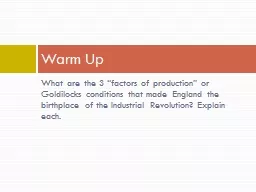PPT-What are the 3 “factors of production” or Goldilocks co
Author : test | Published Date : 2017-10-18
Warm Up Social impacts of industrial revolution Factory Production Factories and growth of cities Most factories were built close to energy sources Water Coal Industrial
Presentation Embed Code
Download Presentation
Download Presentation The PPT/PDF document "What are the 3 “factors of production�..." is the property of its rightful owner. Permission is granted to download and print the materials on this website for personal, non-commercial use only, and to display it on your personal computer provided you do not modify the materials and that you retain all copyright notices contained in the materials. By downloading content from our website, you accept the terms of this agreement.
What are the 3 “factors of production” or Goldilocks co: Transcript
Download Rules Of Document
"What are the 3 “factors of production” or Goldilocks co"The content belongs to its owner. You may download and print it for personal use, without modification, and keep all copyright notices. By downloading, you agree to these terms.
Related Documents














